Costa Rica
Pura Vida
Die Lebensfreue ist in Costa Rica allgegenwärtig. Bunt, verspielt und fröhlich kommt alles daher. «La Pura Vida – das pure Leben» mit all seinen Facetten wird von den Ticos in vollen Zügen gelebt.

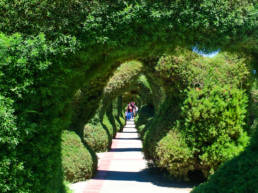
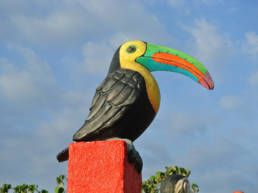
Costa Rica
Wildlife
Leguane sind oft in Costa Ricas Gärten anzutreffen. Gut getarnt hocken sie während der Mittagshitze im Schatten der Sträucher. Am späteren Nachmittag schleichen die bis zu zwei Meter langen Echsen gemächlich zum Pool, wo sie sich am kühlen Nass laben und für die Kameras der Hotelgäste posieren. Pumas, Jaguare und Ozelotkatzen sind nachtaktiv und zeigen sich selten. Freche Waschbären oder amüsante Nasenbären laufen einem hingegen ab und zu über den Weg. Wer aufmerksam in die Baumkronen schaut, entdeckt Faultiere und putzige Äffchen. Auf geführten Touren weisen die Ranger auf Tiere hin. So haben wir den kleinen Frosch im Astloch entdeckt.

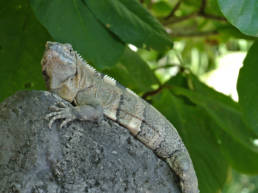
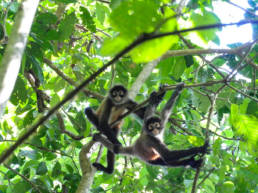
| 1 | Leguane beherrschen das «Posing» in Perfektion | 2 | Auf kühlen Steinen geniessen Leguane den Schatten | 3 | Die wilde Bande hört man, bevor man sie sieht
Iguanas are often found in Costa Rica’s gardens. Well camouflaged, they squat in the shade of the shrubs during the midday heat. Later in the afternoon, the lizards, up to two meters long, leisurely sneak to the pool, where they feast on the cool water and pose for the cameras of hotel guests.
Pumas, jaguars and ocelots are nocturnal and rarely show themselves. Cheeky raccoons or amusing coatis, on the other hand, run across your path from time to time. If you look carefully into the treetops, you will discover sloths and cute little monkeys. On guided tours the rangers point out animals. That’s how we discovered the little frog in the knothole.
Costa Rica
Wildlife
Leguane sind oft in Costa Ricas Gärten anzutreffen. Gut getarnt hocken sie während der Mittagshitze im Schatten der Sträucher. Am späteren Nachmittag schleichen die bis zu zwei Meter langen Echsen gemächlich zum Pool, wo sie sich am kühlen Nass laben und für die Kameras der Hotelgäste posieren. Pumas, Jaguare und Ozelotkatzen sind nachtaktiv und zeigen sich selten. Freche Waschbären oder amüsante Nasenbären laufen einem hingegen ab und zu über den Weg. Wer aufmerksam in die Baumkronen schaut, entdeckt Faultiere und putzige Äffchen. Auf geführten Touren weisen die Ranger auf Tiere hin. So haben wir den kleinen Frosch im Astloch entdeckt.



Iguanas are often found in Costa Rica’s gardens. Well camouflaged, they squat in the shade of the shrubs during the midday heat. Later in the afternoon, the lizards, up to two meters long, leisurely sneak to the pool, where they feast on the cool water and pose for the cameras of hotel guests.
Pumas, jaguars and ocelots are nocturnal and rarely show themselves. Cheeky raccoons or amusing coatis, on the other hand, run across your path from time to time. If you look carefully into the treetops, you will discover sloths and cute little monkeys. On guided tours the rangers point out animals. That’s how we discovered the little frog in the knothole.
Costa Rica
Grüne Hölle
Mehr als fünfzig Prozent von Costa Rica ist mit Wald bedeckt. Rund die Hälfte der Regen- und Nebelwälder steht unter Naturschutz. Die 26 übers ganze Land verstreuten Nationalparks sind Touristenmagnete. Mit etwas Geduld lassen sich darin Affen, Faultiere, Nasenbären, Waschbären und viele weitere Arten entdecken. Im Parque Manuel Antonio lässt es sich auch ganz herrlich baden.
Spannung ist bei den Top-Tree-Walks garantiert. Über die Hälfte des Landes ist von Wald bewachsen – um diesen weiterhin zu schützen, setzt Costa Rica vermehrt auf den hochpreisigen Ökotourismus. Und den Leuten gefällts. Wer keine Lust auf Spaziergänge hat, kann sich an einem Seil durch den Regenwald schwingen oder über eine der vielen Hängebrücken schaukeln.
Über hundert Vulkane finden sich in Costa Rica. Einige davon sind abgetragen und überwachsen, andere wie der Arenal sind hingegen gut erkennbar und immer noch aktiv. Am Fusse des feurigen Kegels liegt La Fortuna mit seinen heissen Quellen.



More than fifty percent of Costa Rica is covered by forests. About half of the rainforests and cloud forests are protected. The 26 national parks scattered all over the country are tourist magnets. With a little patience, you can discover monkeys, sloths, coatis, raccoons and many other species. Parque Manuel Antonio is also a great place for swimming.
Suspense is guaranteed by the Top Tree Walks. More than half of the country is covered by forests – in order to keep protecting them, Costa Rica increasingly relies on high-priced ecotourism. And the people like it. Those who don’t feel like taking a walk can swing through the rainforest on a rope or sway over one of the many suspension bridges.
Costa Rica boasts over one hundred volcanoes. Some of them are eroded and overgrown, others like the Arenal are still active. At the foot of the fiery cone lies La Fortuna with its hot springs. Outdoor fans race through the rainforest on a zip-line in one of the surrounding nature parks.
Costa Rica
Sandstrände
Costa Rica wird von zwei Ozeanen begrenzt: Im Westen brandet der Pazifik an die Küste, im Osten ist es der Atlantik. War es früher das Gold der Azteken, das die spanischen Eroberer nach Costa Rica lockte, so sind es heute die kilometerlangen Traumstrände und die unberührte Natur, die zahlreiche Besucher in das kleine Land zwischen den Ozeanen bringen.

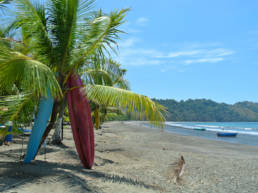

Costa Rica is bordered by two oceans: In the West the Pacific surges to the coast, in the East it is the Atlantic. In the past it was the gold of the Aztecs that attracted the Spanish conquerors to Costa Rica, today it is the miles of dream beaches and the untouched nature that bring numerous visitors to the small country between the oceans.
Costa Rica
Blütenpracht
Costa Rica gehört zu den zwanzig an Biodiversität reichsten Ländern der Erde. Rund 12 000 Pflanzenarten wurden bisher gezählt, darunter mehr als 1000 Orchideenarten. Nicht umsonst wird das Land auch «der Garten Amerikas» genannt – oder «die Schweiz Südamerikas».
Es müssen nicht immer Kapuzineräffchen oder monströse Leguane sein. Baumriesen, Schlingpflanzen und farbintensive Bromelien bieten sich auf Schritt und Tritt als attraktive Fotomotive an. Weitere Kuriositäten sind Würgfeigen, riesige Baumfarne und dichte Moose.

| 1 | Kallige Farben, wie sie nur die Natur hervorbringt | 2 | Aufsitzerpflanzen suchen sich den besten Platz am Licht | 3 | Junge Blätter spriessen
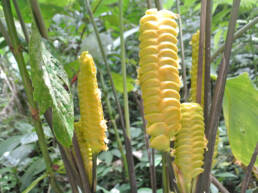

Costa Rica counts among the world’s twenty countries with the richest biodiversity. Roughly 12,000 different plants have been recorded so far, of which more than 1,000 types of orchids. It’s not without reason that the country is dubbed “garden of America” – or “Switzerland of South America.”
It doesn’t always have to be capuchin monkeys or monstrous iguanas. Tree giants, climbing plants and color-intensive bromeliads make for attractive photo motifs at every turn. Other curiosities include throwing figs, huge tree ferns and dense mosses.
Costa Rica
Wilde Affenbande
Sie sind unüberhörbar. Die eher trägen Brüllaffen verteidigen ihr Revier durch lautes Gebrüll. Weit flinker springen die scheuen Totenkopfäffchen von Ast zu Ast. Aufmüpfig und frech sind hingegen die Kapuzineräffchen. Sie wagen sich auch in die Nähe von Menschen und machen sich über jeden Rucksack her.
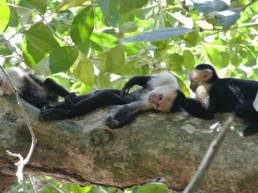
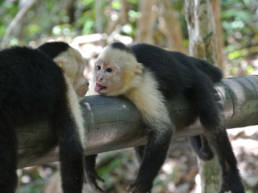

They are unmistakable. The rather lazy howler monkeys defend their territory by yelling loudly. The shy squirrel monkeys jump from branch to branch far more nimbly. The capuchin monkeys, on the other hand, are rebellious and cheeky. And they are not afraid of getting close to humans and attacking their backpacks.
